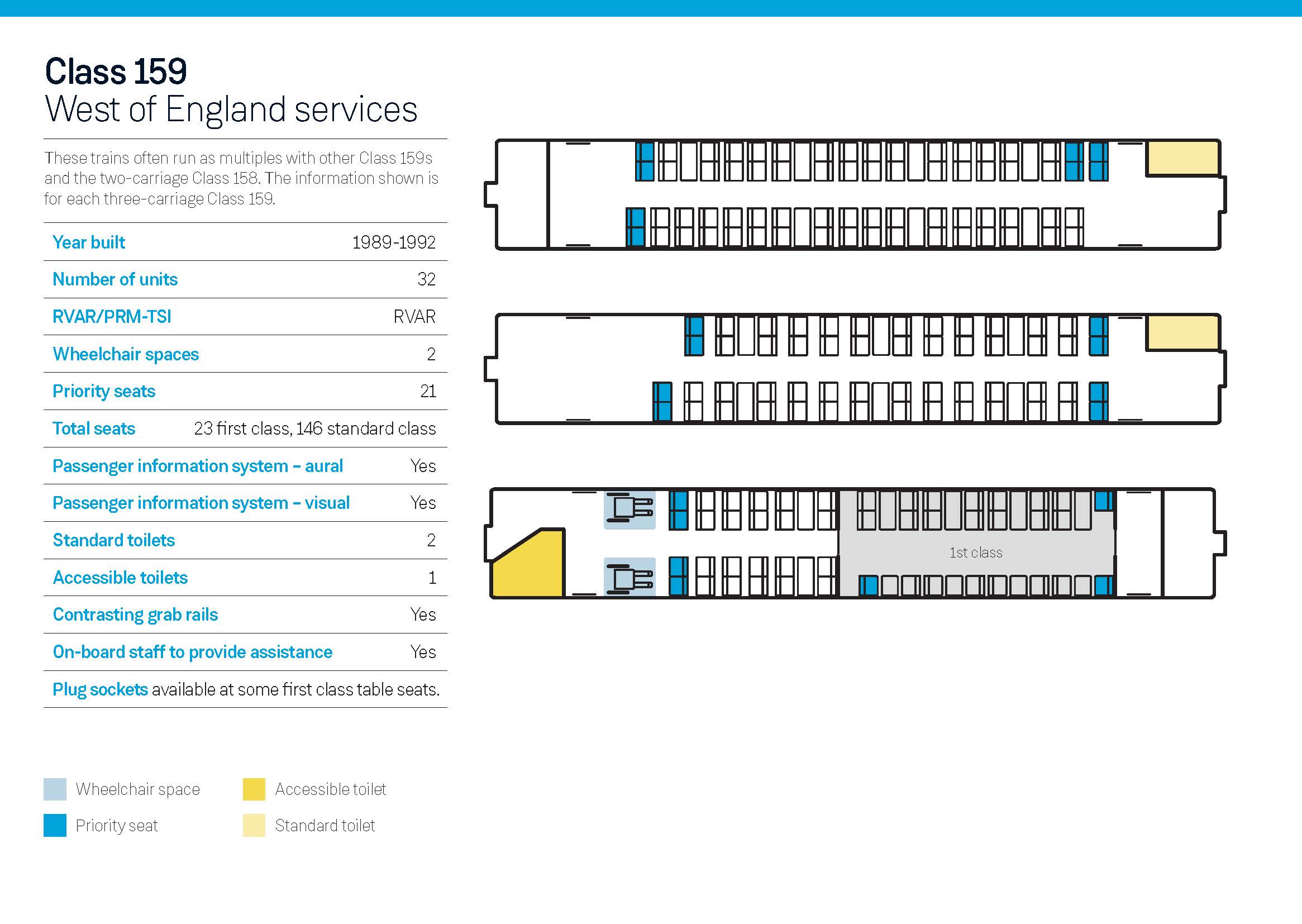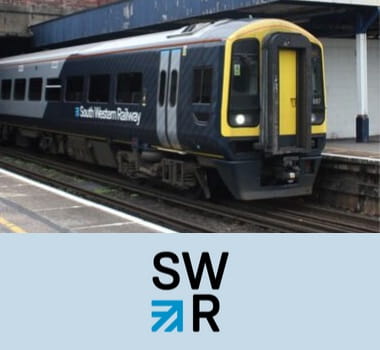The Class 159 South Western Turbo is a three-carriage diesel train that is used on long-distance routes and on rural routes in the Salisbury area. We have 32 of these trains. You'll see Class 159 South Western Turbo trains operating between:
- London Waterloo and Exeter
- London Waterloo and Salisbury
The Class 159 South Western Turbo came into service between 1989 and 1992, and was built by British Rail Engineering Limited. These trains have three carriages, and replaced many of the British Railway locomotive-hauled trains used before. They can operate "in multiple", which means that up to three trains can run together as a nine-carriage train. They will sometimes work with our Class 158 Express Sprinter trains.
Train plan

How many seats does a Class 159 South Western Turbo have?
A Class 159 South Western Turbo has 146 Standard Class seats, and 23 First Class seats. 21 of these seats - 18 in standard class, and 3 in first class - are designated priority seats.
How many Cycles can a class 159 South Western Turbo carry?
A Class 159 South Western Turbo can carry 2 cycles. They can't carry tandem bicycles or trailers. Find out more about our cycle policy.
How many wheelchair users can travel on a Class 159 South Western Turbo?
Two wheelchair users can travel safely in standard class on a Class 159 South Western Turbo.
What accessible features does the class 159 South Western Turbo have?
Our Class 159 South Western Turbo trains have:
For physically disabled people:
- Power-operated external doors, which contrast with the rest of the train. At low platforms wheelchair users may have some difficulty reaching the door open buttons from outside the train.
- Large external door operation buttons, with what the button does clearly marked in English and Braille. They contrast with the door and light up when active.
- Gender-neutral lavatories are provided throughout the train. A universal lavatory with call-for-aid buttons can be located in the area near the position wheelchair users. There are also handholds and a low-level sink with button-activated water and hand dryer. There may not be adequate room to manoeuvre a larger wheelchair or scooter inside the lavatory.
- Call for aid buttons near each wheelchair position, with direct communication to the driver.
- An on-board ramp with locking pins for the train that the crew are trained to deploy. The gap between the train and platform can often be difficult for wheelchair users and customers with limited leg and upper body strength. Assistance joining and leaving the train is available from the crew.
For D/deaf, hard-of-hearing, and sound-sensitive people
- Assistance dogs are welcome on board but must be kept on a lead.
- An on-board audiovisual announcement system in English. This system issues the stations where the train stops, as well as security and safety messages. The system can be overridden by the on-board crew.
- A quiet carriage.
- Our crew all carry smartphones, which you can use for alternative forms of communication if needed.
- These trains have powerful diesel engines and gearboxes, which can be heard on board. When the train is accelerating or at high speed, the engines can be loud and heard clearly in the carriage.
For blind, partially-sighted people, and photosensitive people
- Assistance dogs are welcome on board but must be kept on a lead.
- Large external door operation buttons, with what the button does clearly marked in English and Braille. They contrast with the door and light up when active. A chime will also sound when the doors have been activated, and an alarm will sound when they are closing.
- Unfortunately the nature of how our trains are powered means that we can't guarantee lighting will be flicker-free. Warm fluorescent lighting is used throughout, with light diffusers.
For Autistic, anxious and Neurodiverse people
- Assistance dogs are welcome on board but must be kept on a lead.
- We welcome anxious or nervous travellers to try the train with us before making a journey. Our ambassador team will happily support individuals or groups at a station, navigating buying tickets, boarding trains, travelling, and seeking help if you need it.
- Our crew all carry smartphones, which you can use for alternative forms of communication if needed.
- The diesel engines and gearboxes on these trains mean that carriages will often vibrate when the train is accelerating. This is completely normal for these trains and will reduce when the train is at a higher speed.
For people with severe allergies or who are immunocompromised
- Our heating and cooling systems are roof-mounted on the train. We're not able to turn these off except in emergencies.
- You're welcome to use a safety/particulate mask on board if you need to.
Header Image: Superalbs - Own work, CC BY-SA 4.0, Link



